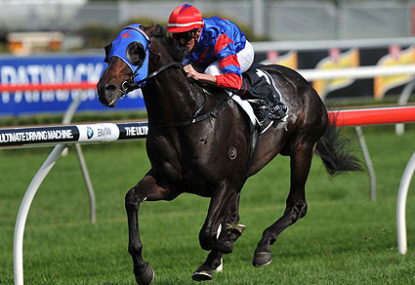'Ride of the century!' Madness as Pride of Jenni wins QE Stakes by ridiculous margin
"This is unbelievable!"

At the conclusion of this season’s Autumn Carnival, three champions in their own right will have begun their journey into retirement.
The long-to-be-remembered Black Caviar, the four-legged nugget Pierro, and great All Too Hard are all set to ditch the limelight to commence family legacies of their own.
All Too Hard has managed to slightly prolong his racing career for another few months, postponing his looming retirement plans after his All Aged Stakes win at the weekend.
The three-year-old colt will assume the number one Australian horse tag until his pension date, as he heads to Europe.
Wouldn’t it have been a fitting send off for this superb trio to clash in a Sydney spectacular?
It has become increasingly evident over recent decades that horse racing is just as much a business and a sport – with the importance placed on a punter’s spectacle becoming increasingly waivering.
In their final days, greats such as All Too Hard and Pierro have been reluctant to enter closely competitive races for fear of detracting dollars from their prized stud fees.
Even New Zealand horse Habibi evaded a battle with fellow Kiwi, It’s A Dundeel recently. No greater example is the race that wasn’t: Black Caviar up against Frankel, who appear to now become breeding buddies.
Star-studded match ups are often avoided by trainers as value is perceived to be lost, with horses unable to string together an unbeaten streak if they are facing other top class horses.
Experiencing a solitary loss should not have the ability to wipe too much value off stallions’ stud fees, particularly when there are established careers involved.
Pierro’s game second in his final race is a prime example, followed by a familiar comment from the respective trainer that, “no admiration should be lost in being beaten by a run like that…”, a frequent response this autumn from hopeful trainers delving into the breeding industry.
As separate industries, breeding and racing are lifelines to one another, inextricably linked by a common species.
However this balance has significantly swung in the other direction over time, with breeding now appearing to heavily outweigh racing, not just monetarily, but in priority (owner’s interests) – ultimately adding greater inquisition to annual sales.
In the past, race earnings were the carrot on the end of a long piece of string for horse owners, whereas now, the instant success of a horse can shorten the length of this piece of this string dramatically.
Future five and six-year-old legends are having their careers cut short by the temptation of a quick and guaranteed breeding buck, and long, dominant careers could well be a thing of the past.
This trend could squeeze the excitement out of the racing industry, to the point where the biggest races become the Slipper, Oaks and Guineas events.
For the second time this year, three year olds have beaten out their older competitors in a Group 1 race. Will this trend create a new era of racing – shorter career spans with greater numbers of champions?
If the tendency for premature retirement is a more prevalent pattern, external factors could be indicted as being to blame, such as the current widespread financial difficulties.
With racing a particularly unpredictable sport at the best of times, breeding is a sure-fire way to make some coin and be assured of avoiding a fiscal failure.
Currently, the breeding hierarchy is able to manipulate the racing industry.
Horses are wrapped in cotton wool and are valued as high market assets.
This would be the case regardless, indeed if they were raced, but as longevity in breeding comes into it, reputations become prized pieces of the portfolio puzzle, protected for future financial benefit.
Previously, horses were usually only retired due to injury and rarely for the sole purpose of breeding. What happens when breeding becomes more expensive than racing? The market will have to saturate at some point.
As stud fees increase, this in turn may increase the price of horses at sale – widening the gap between premium and select options for buyers. The onus falls to the breeder, where they need to decide against value for the buyers against the value to breed.
For example, is it really worth having a superstar stand at your stud, or create a potential stunner out of nothing that will attract large money?
Remarkable mare Sunline raced almost twice as many races (48) as Black Caviar (25), although whether this is a testament to Sunline’s class or the level of injury risk Peter Moody’s superstar was experiencing could be debatable.
Lonhro (35) and Octagonal (28) possess some of the lowest race numbers of Australia’s Top 20 highest earners.
The remaining horses in the top ten have all run in upwards of at least 36 races, with Makybe Diva (1) being at this level.
In fact, horses with unbeaten streaks of 13 or more in the last 30 years have failed to race more than 19 (Pepper’s Pride), with others including Frankel (14) and Personal Ensign (13). Even Phar Lap managed 51 starts and was still going strong before his death.
Historically, great thoroughbreds Kindergarten (35), Gloaming (65) and Carbine (35) also raced beyond their tether.
Surely there is an also an element for the owners themselves. Not all owners are in it for the money, with a majority in it for the excitement, I would have thought.
Money and excitement go hand in hand for most I would expect.
Solutions have been suggested, such as imposing a minimum stallion standing age, however there is a long way to go to instigating any measures such as this and even this would likely be deemed impossible.
I do not blame the breeders, as everyone is expected to make a living and maximise financial gains – but when it begins to detract from racing events, the public’s genuine interest in the sport is impacted.